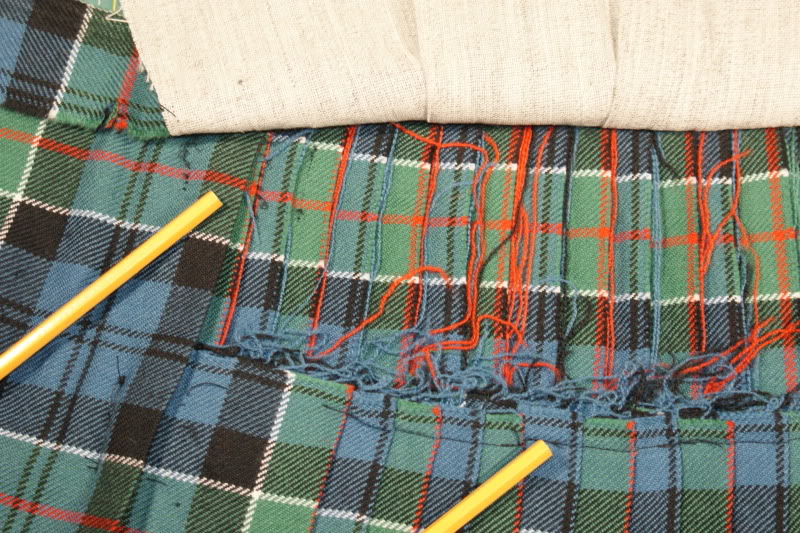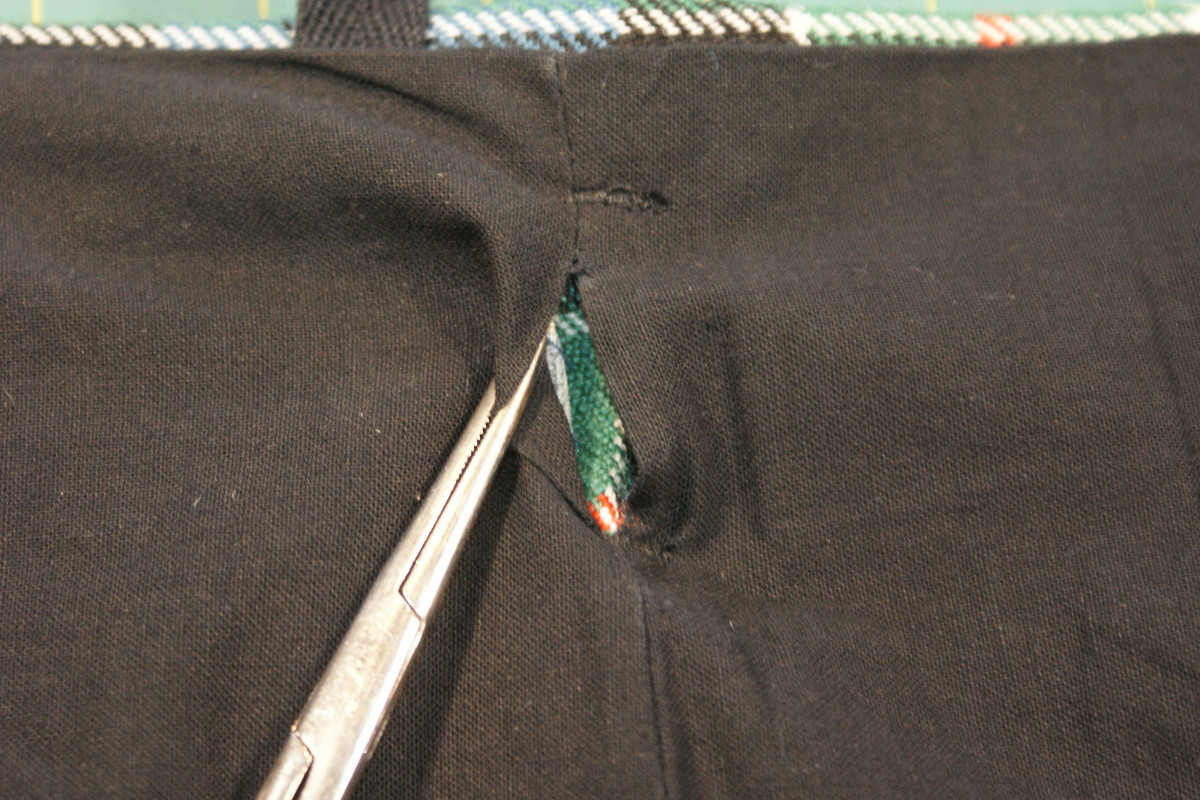|
-
15th December 11, 04:09 PM
#21
-
-
15th December 11, 04:18 PM
#22
Re: Do kilts have a "break-in" period?
I now come to the area of the kilt where I suspect the biggest problem is.
This this with the interfacing and the stabilizer.
Here is a photo of the interfacing in the area of the Fell behind where the pleats are sewn down and tapered .
If you can see, there are just a few stitches sewing the interfacing to the outer, Tartan fabric of the kilt. When I make a Traditional style kilt this interfacing is sewn down to the Tartan fabric with 5 or 6 horizontal rows of blanket stitching. This is to allow the interfacing to act as a single piece of fabric across the back of the kilt, taking all the stress off the Tartan fabric.

Please note in the upper left corner of the cream colored interfacing. If you can see two vertical lines of machine stitching.... This is where the buckles are sewn to the interfacing.
Now, probably, the maker thought that because they machine sewed this kilt that the stitching would not need a lot of reinforcing. Perhaps it is just how they were taught. But this stitching of the interfacing, as it is done, is not reinforcing the back of the kilt at all.
Also note how the waistband is made. The wide stretch of tartan you see covering the top of the interfacing is where the waistband is folded down from the top most likely allowing the maker to machine stitch the waistband without running off the edge.
Last edited by Steve Ashton; 4th July 19 at 10:54 AM.
Steve Ashton
www.freedomkilts.com
Skype (webcam enabled) thewizardofbc
I wear the kilt because: Swish + Swagger = Swoon.
-
-
15th December 11, 05:18 PM
#23
Re: Do kilts have a "break-in" period?
I now have the kilt disassembled as much as I need to evaluate it fully.
Here is a photo of the last part of the kilt I needed to see. This is the area under the interfacing where the stabilizer usually is.

In this area you can see where the pleats are cut away to keep the kilt from being bulky in the back.
The two top pencils you can see are pointing at where the buckles are located on the back of the kilt.
Here is a detail of this area under the interfacing.

If you look at where the lower pencil is pointing you can see a line of stitching along the pleats. This is called the "Steeking". Because the pleats are cut away they need to be stitched to keep them from sagging under their own weight. The steeking line is usually sewn so that it is not visible. I think this detail on this kilt also needs to be re-done.
You can plainly see that there is no stabilizer installed in this kilt. The buckles were sewn through the Tartan fabric and directly to the interfacing. But because the interfacing itself was not sewn to make it act as a single piece of fabric, the folds in the interfacing acted like an accordion allowing the size of the kilt to stretch.
The next thing now is to start putting this kilt back together.
Last edited by Steve Ashton; 4th July 19 at 10:56 AM.
Steve Ashton
www.freedomkilts.com
Skype (webcam enabled) thewizardofbc
I wear the kilt because: Swish + Swagger = Swoon.
-
-
15th December 11, 08:02 PM
#24
Re: Do kilts have a "break-in" period?
Absolutely fantastic Steve, thanks for putting this up. Any chance of making it a sticky? It would be great to have it for ready reference.
Shoot straight you bastards. Don't make a mess of it. Harry (Breaker) Harbord Morant - Bushveldt Carbineers
-
-
15th December 11, 08:19 PM
#25
Re: Do kilts have a "break-in" period?
WOW!!! That was impressive Steve, any chance we will find out who originally made this kilt? Just curious is all, I know it was still a nice kilt, just for FYI you might say.
-
-
15th December 11, 08:40 PM
#26
Re: Do kilts have a "break-in" period?
Impressive deconstruction! Fascinating! I'm not brave enough to take any of my kilts apart, but I'm going to look a lot more closely at their make up, and do the stretch test on one that has a similar problem as Tobus'. I know this might seem common sense to those here who have made their own kilts (and especially to those that make them for a living) but for the lay person, this is great knowledge! Thank you for sharing.
If I can make a leap here, can it be assumed that all quality kilt makers with good reputations will be this thorough in constructing their kilts? How does the "regular Joe" with limited experience know he's gotten what he paid for? Or for that matter to even know what to ask for? I'm guessing the answer will have something to do with having several conversations with the maker?
Thanks again for this topic Tobus and Steve.
"Guests, like fish, begin to smell after three days." Benjamin Franklin
-
-
15th December 11, 08:53 PM
#27
Re: Do kilts have a "break-in" period?
Bravo Steve!
This should be stickied in some sort of FYI format for all would-be kilt shoppers.
 ith: ith:
edit: My apologies for echoing exactly DownunderKilt's thoughts- I enthusiastically replied to Steve's post w/o fulling reading the rest of the thread.
Last edited by artificer; 16th December 11 at 06:20 AM.
-
-
15th December 11, 09:27 PM
#28
 Re: Do kilts have a "break-in" period? Re: Do kilts have a "break-in" period?
 Originally Posted by Downunder Kilt

Absolutely fantastic Steve, thanks for putting this up. Any chance of making it a sticky? It would be great to have it for ready reference.
*** 
[SIZE="2"][FONT="Georgia"][COLOR="DarkGreen"][B][I]T. E. ("TERRY") HOLMES[/I][/B][/COLOR][/FONT][/SIZE]
[SIZE="1"][FONT="Georgia"][COLOR="DarkGreen"][B][I]proud descendant of the McReynolds/MacRanalds of Ulster & Keppoch, Somerled & Robert the Bruce.[/SIZE]
[SIZE="1"]"Ah, here comes the Bold Highlander. No @rse in his breeks but too proud to tug his forelock..." Rob Roy (1995)[/I][/B][/COLOR][/FONT][/SIZE]
-
-
16th December 11, 05:51 AM
#29
Re: Do kilts have a "break-in" period?
This is awesome stuff. It's like "kilt anatomy 101". Or a Chilton's manual showing you what your engine looks like when you take it apart. 
Yes, it's slightly difficult to see my kilt being gutted on Steve's table. But it's necessary. In fact, from what I'm seeing, if I had worn this kilt much longer with the fabric being stretched and the stitching being stressed like it was, I'm afraid I might have done more permanent damage. So I'm glad we caught this when we did. At this point, I'm assuming the kilt can be retrofitted with a stabilizer and proper interfacing, and returned to service.
To answer the question that's been asked several times, I don't know who made this kilt. I can tell you who I bought it from, but that's not who made it. This kilt came from Skye Highland Outfitters about a year and a half ago. This was the original thread from when I received it. The kilt was, according to Josh, made in Scotland by someone he subcontracted there. I have no clue who he was using then for constructing traditional kilts, or who he's using now. The size 34 tag in there suggests that it was done by a somewhat industrial shop, though that's just a guess on my part.
I consider this a classic example of needing to do one's homework before spending money on a kilt. And talking to the actual kiltmaker directly. When I bought this kilt, I didn't know what questions to ask. All I knew was that I wanted an 8-yard, 16-oz kilt. And his price looked pretty good. But as I'm learning now, there's a lot more to it than that, in terms of how a kilt is actually built. I didn't really think I should need to know the finer points of kilt construction details in order to get a quality kilt. I know better now, and my next kilt will come from a top-quality kiltmaker with a long history of excellent work, with whom I deal directly.
This isn't to say that my kilt is junk. It's a good kilt - it fits me well and looks great, has great swish, and is made from quality fabric (Lochcarron Strome, IIRC). But it just has a couple of deficiencies in the way it was built. Hopefully we'll be able to retrofit it and get it back on the road. And provide some education for the rabble along the way. Not only in terms of how kilts are (or should be) made, but in terms of why quality craftsmanship matters.
This is good stuff! Information like this is why this forum is invaluable.
-
-
16th December 11, 08:44 AM
#30
Re: Do kilts have a "break-in" period?
 Originally Posted by Tobus

This is good stuff! Information like this is why this forum is invaluable.
Indeed, just when you think we have talked about it all, you start a thread like this and Steve ends up taking us all to school, pretty neat in my opinion. Thanks for the heads up about the origin as well. Just wanted to make sure it was not made from the company I had planned on using for my next kilt. Again, I know it was a quality kilt, but still, don't want to have to worry about this myself. The worst part is I am the type of person who would have just made up an excuse and ignored the problem. I would have thought there was nothing wrong with the construction of the kilt. Good to know you are not so easily fooled.
-
Similar Threads
-
By Hamish in forum Contemporary Kilt Wear
Replies: 27
Last Post: 24th February 09, 07:27 PM
-
By S.G. in forum General Kilt Talk
Replies: 17
Last Post: 30th July 08, 03:21 PM
-
By Makeitstop in forum DIY Showroom
Replies: 28
Last Post: 25th July 08, 09:56 AM
-
By Woodsheal in forum How to Accessorize your Kilt
Replies: 12
Last Post: 23rd January 07, 07:00 AM
Tags for this Thread
 Posting Permissions
Posting Permissions
- You may not post new threads
- You may not post replies
- You may not post attachments
- You may not edit your posts
-
Forum Rules
|
|




























Bookmarks